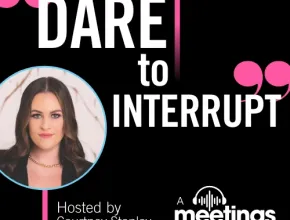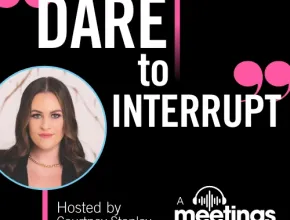Peer Into the Future: A Cvent Case Study on Hybrid Extended Engagement
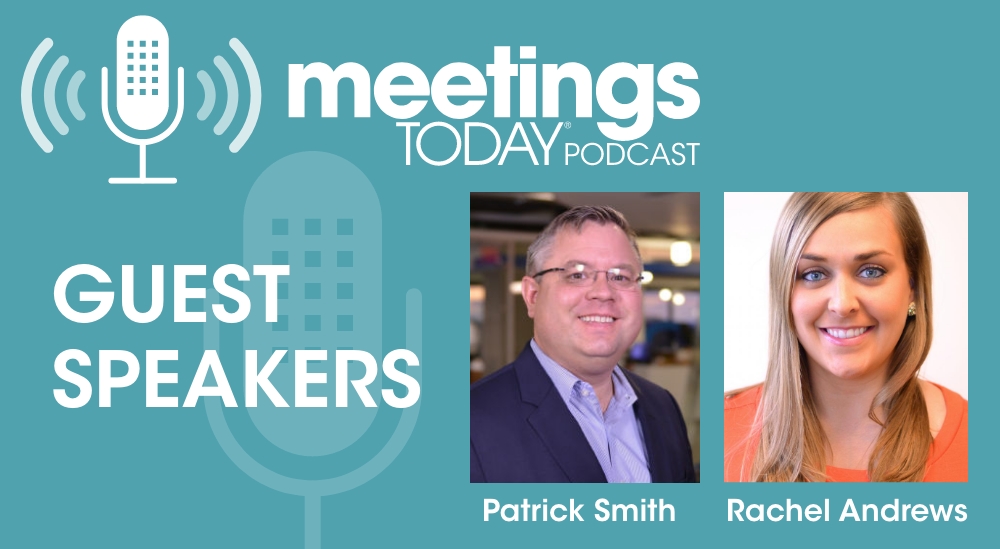
Many planners think a hybrid event is simply a program that ties together a single in-person event with a simultaneous digital component. Think again!
Meetings Today's Tyler Davidson talks with Cvent's Rachel Andrews, senior director, Global Meetings & Events, and Patrick Smith, senior vice president and chief marketing officer, about their experience producing the hospitality tech giant's Cvent Travel Summit, which featured specialized content for different subsets of audience and multiple event formats, as well as in-person elements in two different countries before and after the main production.
Sound complicated? Let Rachel and Patrick share how they pulled it off, because hybrid meetings are here to stay and the race is on to deliver the most engaging and relevant experience for all attendees.
Listen to the episode:
[Free Cvent Webinar: Prepared for Anything: How to Set Up Your Event Program to Weather Any Storm]
Transcript:
Tyler Davidson: Hello, and welcome to this Meetings Today Podcast. I'm Tyler Davidson, chief content director of Meetings Today, and joining us today is a couple folks from Cvent [who are] really well involved in all sorts of different meetings—hybrid, in person, every kind of permutation of a meeting can imagine.
We have Patrick Smith, senior vice president and chief marketing officer, as well as Rachel Andrews, senior director of Global Meetings & Events for Cvent. Thanks for joining us, Patrick and Rachel.
Rachel Andrews: Excited to be here, thanks.
Tyler Davidson: Well, the idea behind this today was really kind of to provide a case study, as it were--four different aspects of your Cvent Travel Summit, and sort of the new wrinkles it took in both guests in person and as a hybrid event program. And I guess, really, the objective was to extend engagement through the use of multiple event formats and specialized content.
And actually, unless I'm wrong, it addressed people in two different countries on this? Maybe explain, first, what the Travel Summit was, which took place in late May, for people listening?
[Listen: Cvent on Future Skills for Meeting Professionals]
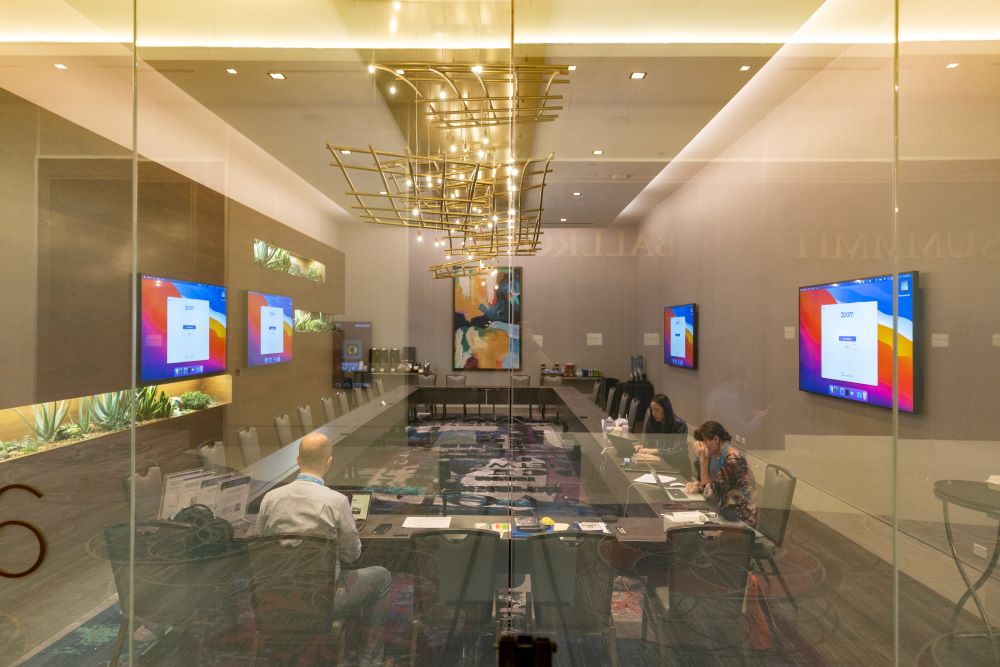
Rachel Andrews: Yeah, so we hosted this event travel summit on May 24. And really, you know, this is supposed to be for leveraging our industry-leading speakers, [and] bringing together our collaborative industry, of how we support the travel space. And so it's really showcasing our services for travel managers, travel management, companies, hotels, procurement, things like that. Because I think that one of the things is that we're big in this space, but we haven't historically done a ton of content on this.
So, this is our second annual event Travel Summit, and it's going well, and we want to continue to do this. I think one of the one of the things was, let's continue to do this but try out some new things. And you know, like every person in the events industry right now, a lot of it is trial and error, learning from what we've done in the past.
But ultimately, bringing together those travel professionals and suppliers was really our main goal, to align them with Cvent products that help travel managers with their own travel programs. Patrick, I don't know if you have anything to add there?
Patrick Smith: I would add Tyler, what's interesting is, as a global market leader, we have so many different markets that we serve. So, you've been this event CONNECT, which is our big user conference and industry conference. And, it's harder and harder to create a program at Cvent CONNECT that covers everything we do.
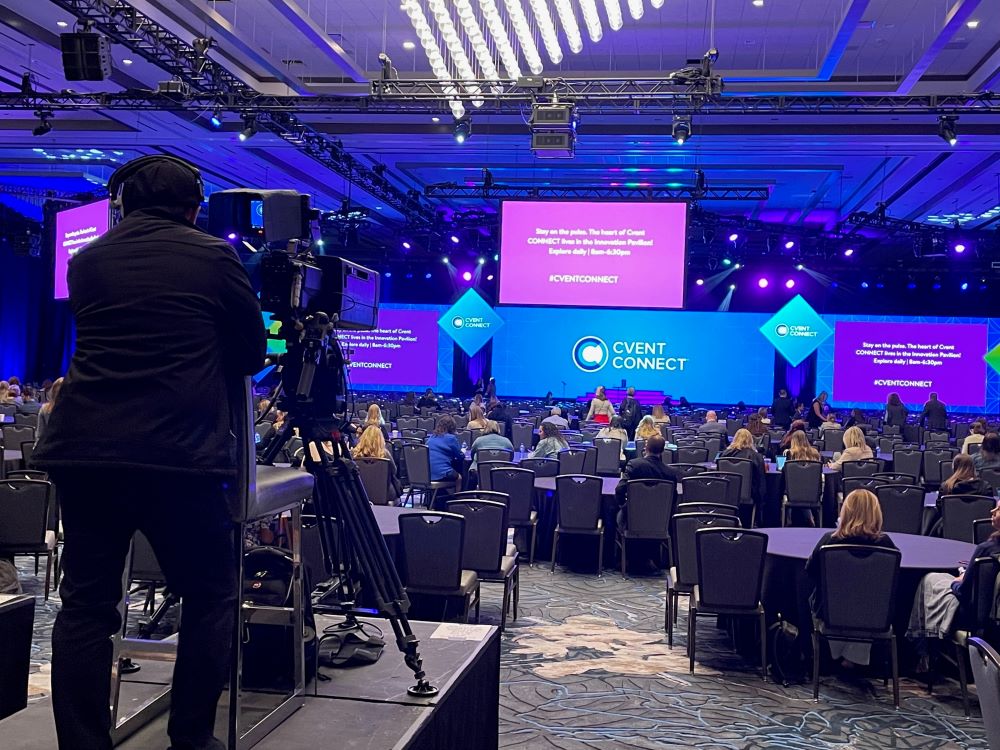
So, that's why it's so important to have offshoot events like this, that maybe we couldn't do it justice, Cvent CONNECT, just because we have so many different types of people there. And to create a couple of different sessions might not be enough value-add for people to come and join. Obviously, you can do it virtually or in-person.
So, the major value-add in our minds is to provide a compelling program with strong content on a specific section of our business in a way that is targeted and robust for that specific audience. And I think it's also respectful of the audience's time, because it's a big ask to spend time with us. So, when you do, we want it to be a huge value-add.
Thus, the reason why we have a specific event just for this segment of our business.
[Listen: Cvent's Perspective: Making Meetings Accessible to All]
Tyler Davidson: in researching this and communicating with you guys before, you mentioned that it gives planners a new perspective on what to think of when they imagine a hybrid event, and I may be in the same camp there. And I always think of a hybrid event as an in-person and a virtual event happening simultaneously. But you're are saying that's not necessarily the case?
Rachel Andrews: I think it can be a couple of different things, Tyler. I think it can be streaming out key content; it could be extended engagement through your content platform, whether it's, you know, having sessions on demand afterwards. Or maybe it's what we did with Travel Summit, and it's a virtual event but then there's in-person networking components.
So, it's not a one-size-fits-all, in my opinion. I think that there's a lot of different ways you can look at hybrid, and that's why it's exciting for me to incorporate that in our total event mix, because there's a lot of areas for opportunity.
For me, and I know you mentioned this in the beginning, but with hosting the Cvent Travel Summit over multiple time zones and having an in-person event in New York and London, it was a unique experience for us doing that in different cities. But what was cool about that is that it opens up this concept of, you know, not all of our customers are in the same timezone, right?
We're allowing participants to join from wherever they are, and it kind of opens us up to this concet of no borders content, or no borders networking, where the people can attend anywhere. And I think that that's part of hybrid that I think sometimes might be missed. And it's not just simplifying it to say, "Oh, I'm just streaming the general session out to attendees." There's so much more engagement that you can implement into your events program through multiple different channels of hybrid.
Tyler Davidson: And, that is such a big concept to wrap one's mind around. You might have one attendee at four in the morning somewhere, for one, and, you know, noon somewhere else. And so I suppose between New York and London, it's not quite as severe, but how do you wrap your head around that? And, you know, you could probably talk for hours and hours on this, but what is the sort of basic strategy in providing content that works around that parameter?
Patrick Smith: Yeah, I think Tyler, in many ways, it's the beauty of being able to have a virtual platform to also showcase content, and do its due selling on-demand way.
You know, I think that's what's really cool—you're creating so many video assets at events these days, and if you have a robust solution, like Cvent offers with our Attendee Hub to showcase that, then someone who is off-timezone can attend if they happen to be up for a piece of it, but then always get that content on-demand after the fact that they can watch and can put things like associated content around the session, [such as] surveys attached to it.
So, even some of these engagement features that you might think have to happen live can also happen in an on-demand way. So, that's really the power of this new world of events where you have all these different formats at your fingertips to experiment with, to combine to mix differently, to get as much of your message out to the broadest group of people as possible.
And that's why we're such big believers in the power of hybrid, because it comes in many flavors, and ultimately, it just increases your reach across the board.
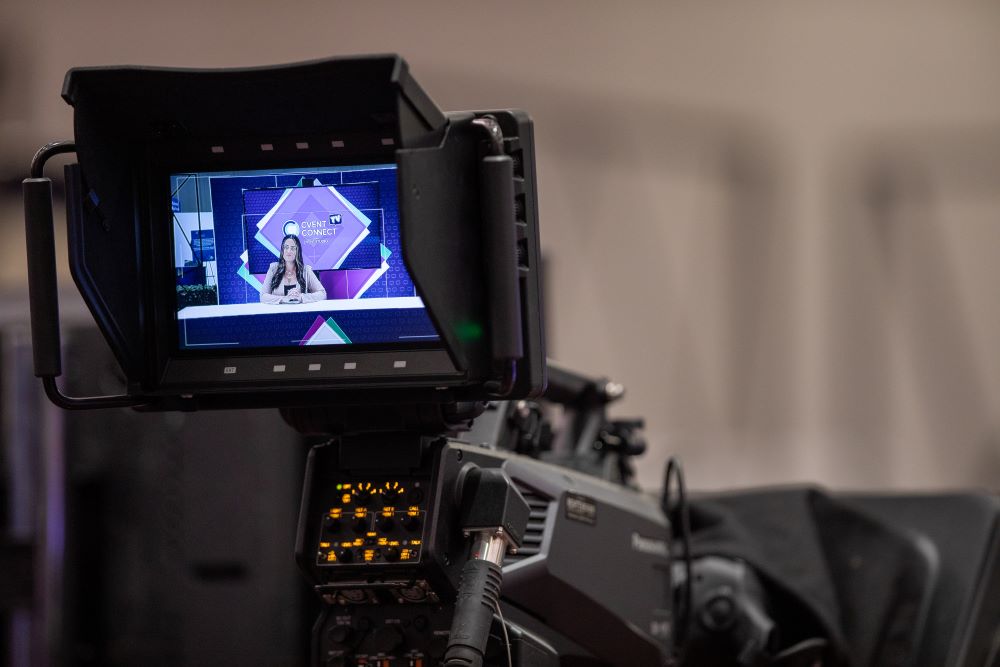
Tyler Davidson: What sort of feedback tools and platforms went into creating all this, and making sure it all dovetailed together?
Rachel Andrews: We used quite a few pieces of Cvent, obviously, working at Cvent, we have the luxury of of using most of our tools here. But, you know, first and foremost obviously our website and registration process—what we do every day here—but we also incorporated the Attendee Hub, which is really the content hub for where people go to interact, where they go to watch content, either live or on-demand. And then we have things like custom pages, virtual booths, instant networking, which we did a bunch of, so people could connect with each other in real time.
So, if I'm in London at, you know, 3 p.m., and I'm online and in the U.S. or East Coast, it's 10:00 a.m., there's some some things that I can interact with across the pond, then that kind of happened, which is great. And then, obviously, we heavily utilize our survey tool. A lot of this, I wanted to mention before, is serving our attendees to see what they want, and part of the reason we decided to go with London and New York was when we started getting interest for the Cvent Travel Summit, we kind of pulled our attendees for who is local and who would be interested in doing some sort of networking event. And with that interest, we were able to host those events.
So, just pre-polling or pre-serving your attendees, I think is crucial in some of these hybrid moments. Because, like I said before, there may be some people that might not be able to go to an in-person event, but they definitely want to watch something online or vice versa. They want to watch online and they want to attend a networking event in person. So that's a big piece of this hybrid strategy—understanding the attendees through a survey tool.
But yeah, we also used our production tools, Cvent Studio, to produce all these sessions, which was awesome. But yeah, with Cvent Attendee Hub we have all these interactive features—chat, polling, Q&A—really trying to drive engagement of our attendees through how we use Cvent.
Tyler Davidson: And how does that build pn your core conferences like CONNECT, or in general?
Patrick Smith: I think it allows us to really stay top-of-mind. Right? I think that's the important thing. And that's really the key to our extended engagement idea is that we might have talked a little bit about the business travel sector at Cvent CONNECT, but now's a chance to really have a dedicated event for that. We have—you're familiar with our Hospitality Cloud, or a supplier and venue solutions that we offer that connect a bunch of different venues—almost 290,000 around the world—to planners and marketers that want to store space.
We have this big network, we have a lot of those hospitality professionals—that's Cvent CONNECT—but they tend to be more senior people. So, we had a user conference just for the HC users in June that was a virtual event as well, to really dive more deeply into the product. We have some of that as Cvent CONNECT, but you can't go as deep as you might want to, at that event, just with all the other things going on.
So, you have some content at Cvent CONNECT, and then you go deeper in certain areas later. And virtual is just a great format for that, because they might have already attended live and can't attend again easily by jumping on a plane or some form of transportation.
So, you have a virtual event, and I think what we're seeing in action is this, not necessarily a hybrid event always, but a hybrid events program that's taking advantage of what we call the triple threat, which is in-person, virtual and hybrid.
And we're even in the webinar space as well and adding that into the mix. So, we understand all the different interactions at events, we know who attended one event that shouldn't be invited to the next event, who we saw at a webinar that we want to meet onsite at the next tradeshow because we think we're going to be there. And that gives us the ability to have really one lens on all the goodness of an events program. And then we use that from a marketing and sales perspective to really follow up appropriately.
So, it's not enough just to look at one event; you have to look across your total event program and aggregate all this intelligence together to take action. That's why having such a thoughtful event program and this hybrid events program view allows us to really maximize that interaction, that engagement, which leads to goodness for us.
Tyler Davidson: There's a lot of moving parts to this, a lot of stuff to juggle. I mean, you guys specialize in this, and you're using your own platform, so you're intimately familiar with all their capabilities.
For other planners and other organizations, what are the benefits and challenges of this sort of concept? And what should they be aware of when they're organizing an event like this?
Rachel Andrews: Patrick and I talk about this all the time, just when we look at our total events program ... CONNECT has so much goodness packed into it, like Patrick just mentioned, but then we get requests out of user groups.
So, you know, or customer advisory boards or whatever, those smaller meetings, sometimes feedback comes out of CONNECT, where it's like, you know, a specific subset of customers want to do, or want a deeper dive into XYZ. And then that kind of spawns some of the things that we want.
So, some of it is request or customer driven, of what is actually needed for our customers or our attendees. And then some of it is literally just making sure people are aware of the different sectors that we have across Cvent—we're a big company, we have a lot to offer—and then drilling that down almost into bite-sized things.
So, whether that's, you know, almost 1,000 events that we're doing per year, whether that's looking at event registration-only training, or if it's just looking at a customer user group or something like that, we look at every different marketing channel and tactic as an opportunity to serve our customers. And folks looking to learn about Cvent, and factor that into our total events program.
So, I think, then we also look at the event formats, Tyler to your point. So I think we need to make sure that for smaller events or larger events that there are equal opportunities, whether it's virtual or in person, and note—you know, it's not a secret; it's returning, and it's coming back kind of with a vengeance—but at the same time, not everybody can travel to everything.
So, for us, it's important to have that mix so that we have those crucial meetings that we need to have in person but then we also have the meetings where someone might not want to travel or come to a meeting for four hours in person, so we're we're looking at that mix almost daily and looking at that percentage of what that looks like into our total events program.
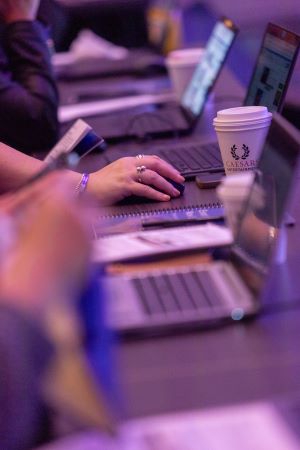
Patrick Smith: And Tyler, I would say that when you look at this event, specifically some of the things that we like to tell planners who create these is, a lot just focus mostly on the virtual side, when you have a production—think TV show, not just PowerPoint—and that's been one of the guidelines across a lot of our virtual events is we want it to look like a TV-show-like experience, not just droning on overtop of slides—people also need a break.
You know, it's amazing. I'm in so many meetings a day, and I guess people feel like if you're still working from home, a meeting can end at three and begin at three, but we do need to go get a glass of water from time to time. So, you know, even things like remembering people need breaks, shorter sessions are better when it's kind of in a virtual broadcast.
I think it's important to take advantage of the engagement features. I was mentioning before some of the different engagement actions you can take. But if you create an event that maximizes the number of engagements that you can drive, and then see that in our attendee hub, we're capturing all these engagement points across almost everything you do.
And that's allowing us to put an engagement score together and rank the most engaged people. And that's incredible intelligence on buying interests on what they might want to see at the next event that we run that we leverage every single day. And I think, take advantage of some captive attention to fill downtime. You know, there's things where people are waiting in a room before the session starts—play an ad package, play a promotional video.
That's the opportunity that you have when someone's watching behind the screen. And one of the other things that we we didn't really hit on earlier that I mentioned now is we love in-person events. It's absolutely coming back. It's really the bedrock of the events industry, in general, in my opinion, is the in-person world. But virtual is extremely important, too.
And I think we find that for things like internal events, whether it's town hall meetings or sales kickoffs, their retention of content that people are getting when they're watching a screen is oftentimes better than sitting in a room where they might be in the back, and the rooms cold and someone's coughing, and they can't see the screen really well.
There's really something nice about virtual content. And that's why even if you have an in-person event, packaging that content up and repurposing it from the on-demand side, for the audience that wants to come back and watch, it can be really beneficial, because then you have the power of in-person. But you can also see that content in a way that's built just for viewing on a computer screen, not watching from a camera in the back of the room.
So, these are the ways to kind of maximize some of the pitfalls to avoid if you're creating an event that has a largely virtual component to it.
Tyler Davidson: And of course, virtual, too, is just prime for data collection, too. And so from that perspective, did this effort yield any interesting or surprising insights?
Rachel Andrews: I think, well, one of the things I keep mentioning is understanding your audience is pretty big here, Tyler. So, you know, we do a lot of pre-event work before an event, just to understand the interests of attendees, I think that one of the things that we kind of learned is that you need to understand the attendees coming to make sure that the content is relevant to those attendees.
And I'll give you an example. You know, some of our customers are well versed in our products, some of them are maybe surface level, so you're hosting that content for them. So some customers might appreciate the deeper dives into products, some might just want best practices to take back to their total events program or group business.
One thing, from a data perspective, we've kind of dialed into and done a really good job of is pushing these targeted persona guides to help people, because when I go to an event website and I look at an agenda it gets kind of overwhelming, especially for a virtual or hybrid event. I don't know what I should attend in person or or virtually, drilling that down to the to the persona level and tailoring those experiences.
So. your attendees don't have to has been a huge learning for us. And getting those insights from that has been huge, because then we can help them map out what their journey looks like. And then the other thing I would say is the it's not really surprising. It's something that really should be standard is tagging content types, so attendees can navigate what they want to do.
So if it's a deep dive training, or thought leadership, or is this more of a roundtable sharing session—or maybe it's a teambuilding session or a networking session—tagging those content types in your agenda is big and will help them navigate on your attendee hub or your platform that you're using to help them with their agenda.
It's not really a surprising insight. It's just something that we need to keep in mind as planners, you might know your content in depth into the core, but your attendees need a little bit more guidance when it comes to this. Interesting. Wow.
So it's been fascinating hearing what you're doing with this. What other sorts of specialized events like that has Cvent done, and anything in the future that we could be looking forward to?
Patrick Smith: Yeah, a couple of things. And then Rachel certainly let me know what your thoughts are. But I think, Tyler, you know, we love different events, and we consider even webinars as events for us.
So, you know, we've done things like using our own software—the attendee has—we've done a webinar series where it's not a "let's just do this webinar on this topic and that webinar on that next topic." It's really plotting out the series in advance. So, you can opt in to the whole series and you can register for all the different sessions, and you can go back and have an expectation that we're going to hit this topic and then continue the conversation with that topic.
So, it's really kind of a programmatic view of webinars and the Attendee Hub that we build is really a great use case, to have that series in the Attendee Hub. I mentioned the Hospitality Cloud user event; that's a way of carrying on the conversation, taking something we did at Cvent CONNECT, and then making it bigger and broader in a very targeted manner. And we're also doing things like high-end experiential events, you know, things like virtual wine tastings and those sorts of things that we find are very nice ways just to have a conversation, you know, have a meetup, get people talking, get people engaging.
That's something that we like to ... and of course, as we said before, in-person is back. And it's a great thing to see. So we have a very, very robust roadmap of internal, in-person events that we're doing, both internally and externally. And obviously, a pretty robust tradeshow program as well.
So, we're going to be out in the market doing a lot, but our product seminar programs back, we do customer success groups and hospitality success groups, as we call them, and other in-person events that are backed up all around the world. So, we love events at Cvent and we use them as a big, big part of our marketing engine.
Rachel Andrews: Yeah, I think I think Patrick covered most of them. Obviously, we have a lot of training programs and user groups going on. Like we just did with the the hospitality user group summit. This week alone, we have a U.K. networking event where we do trends, and then we have networking, you know, drinks.
Today, it's actually happening right now. And then tomorrow, I think we have it, Cvent Accelerate, which is in Singapore, which is a hybrid conference, and they're doing a lot of virtual speakers who are coming in and being part of it. But then, also, we have networking and a happy hour after the in-person event.
So, there's just a lot, obviously; we have CONNECT coming up, Tyler. We have CONNECT in October for the U.K. market. And like Patrick mentioned, tradeshows is a huge part of our total events program that we call events, we attend type of thing. And it could be a tradeshow an industry event; any sort of event out in the market.
And we do a ton of activations around that, so whether it's content capturing in our booth or it's just doing meetings in person plus a networking event, there's tons of that coming back. So, it's really an all around crazy mix of both hybrid, in-person and virtual we have going on.
Patrick Smith: Yeah, and one note on hybrid, too, Tyler, is Cvent CONNECT Europe event coming up October, I think four to six in London. You know, it's for the entire European audience, and even people from the Middle East attend.
But we did have people attend Cvent CONNECT—U.S., if you want to call it that--in Las Vegas, which is our flagship event, from Europe. So, we don't necessarily actively promot it as hard because we have our European event. But virtual events are the virtual component of an in-person event. And in this case, a hybrid event can be attended from anywhere.
So, we saw a lot of interesting interaction from people all around the world, even with the timezone constraint, attending Cvent CONNECt. And that's, again, the power of hybrid, because we really believe if you put so much work—and Rachel leads an amazing team—but there's hundreds of people at Cvent that contribute to Cvent CONNECT.
When you're putting all that work in, you want to show your brand and all that great content and all the power of events to as many people as possible. And that's why the hybrid angle is so great. You get those really important people onsite, you get the people that want to have a great in-person experience, you build those relationships. And you're also talking to 1,000s more online, too, and they more often than not might attend in-person in the following year because they want to be there onsite.
So, this is the really amazing events world that we're in these days, and one that we're really passionate about. And it's why, as we've talked about, we think the golden age of events is here where events are more impactful and numerous than ever before.
Tyler Davidson: Excellent. Well, thanks for joining us today.
Patrick Smith: Of course. Great. Thanks for having us.
Tyler Davidson: Yep, I look forward to jumping in and then kind of discovering and experiencing all the other stuff you're working on. It's certainly a boatload of stuff. You guys are both pretty impressive for doing all of this. So, thank you.
Rachel Andrews: We're having a good time, Tyler! We're forging forward in a new world..
Tyler Davidson:....you're missing out on that European happy hour, Rachel!
Patrick Smith: Yeah, we haven't learned how to teleport yet. But once we do, then we can really, you know, take the in-person program to the next level.
Tyler Davidson: That's next year, you'll figure out teleportation.
Well, thank you. That was Patrick Smith, senior vice president and chief marketing officer, and Rachel Andrews, senior director, global meetings and events for Cvent.
Thanks for joining us for this Meetings Today Podcast. If you're interested in some of the other podcasts we've done with meetings and events industry thought leaders, head on over MeetingsToday.com and check out our podcast section.
So whatever you're up to rest of the day, go out and make it a great one. And thanks for joining us.
Listen to More Meetings Today Podcasts



